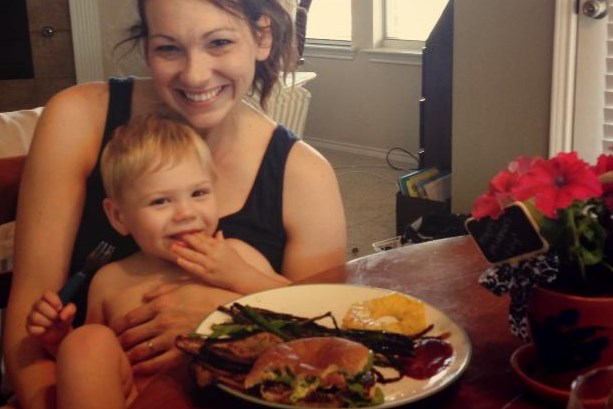What are your childhood memories of eating at the family table? Warm and happy? Or angst-riddled?
Just because well-intentioned parents forced their kids to eat foods they loathed or sent them to bed without supper, doesn't mean we have to perpetuate the madness. Our generation also grew up with lots of obesity, anorexia and other food disorders.
Drawing upon what we know about happy, healthy, normal-weight adults, here are "Twelve Tips for Avoiding Tears at the Table." These hints will help your kids enjoy food without guilt, over-indulging or extreme dieting. In other words, without all the issues our generation has battled.
1.If your kids say, "I'm starving!" and dinner is more than 10 minutes away, let them nibble on veggies or nuts, a bite of cheese or a teaspoon of peanut butter. If children get ravenous they can experience headaches and shakiness. Unless they get food right away, it can be hard to calm their systems down. They might not be as hungry when dinner is formally served, but neither will they be in Low Blood Sugar Meltdown.
2.Teach your kids about true hunger, and offer them only healthy food choices. Say, "Close your eyes and tell me if you are just a little hungry or really hungry? Think about eating a few strawberries or a slice of cheese. Which one do you think will make your tummy feel better right now?" Remember that activity and growth spurts can cause a sudden rise in appetites. Let their true hunger lead the way.
3.Don't sweat it if your child eats the same foods from a small menu of favorites. If their choices are nutritious and there's variety between protein, whole grains and fresh produce over the length of the day, they'll be fine. Most children have limited palates, but over time they will broaden their tastes.
4.To raise veggie-loving kids, teach them how to pick out the best produce from the store, farmer's market or garden; then, let them help you prepare it. Bone up on recipes and ways to cook veggies that really do taste delicious. Kids love the naturally sweet flavor that comes from roasting veggies. Let kids make "veggie creations" out of the leftover peels, stems leaves, using toothpicks to put them together.
5.Establish pleasant mealtime manners. Teach your kids to 1) ask to be excused when they are finished, 2) thank the cook for a good meal, 3) take their plate to the kitchen sink, and 4) play somewhere quietly while others finish their meal.
6.Keep conversations around the table upbeat, void of negativity or criticism. Starting a meal with a blessing is one way to set a positive, grateful mood. A great discussion starter is, "Tell me the best thing that happened to you today?"
7.If a child doesn't like what's served and you know this to be true, don't force it. Have a few fast and easy alternatives for them to choose from. If they are old enough, they can make their own snack. A peanut butter sandwich, bean and cheese tortilla, string cheese and fruit, a quickly scrambled egg, or a protein smoothie are healthy and simple to prepare.
8.Make it fun to try new foods. Do a "toothpick" snack lunch or serve familiar items along with a couple of unfamiliar foods on kabobs with a yummy dipping sauce. Cut new foods into bite-sized tapas. Kids love eating small bites served in plastic deviled egg plates.
9.Teach your kids the joy of water. Serve water in a special drinking bottle or cup and let it be their go-to beverage. Make sure they take their bottle of water with them in the car. Leave a cup or bottle of water at their bedside so they can get sips at night by themselves. Get them used to staying hydrated with pure water so they won't mistake thirst for hunger.
10.Don't withhold food as a punishment. It is nearly impossible for a child to fall asleep hungry, and borders on cruelty. If they react to low blood sugar with headaches and nausea, you can induce sickness by withdrawing food. It also teaches them to equate food with a painful or shaming experience.
11. Assess the reasons behind misbehavior at the table. Are your kids tired? Sick? Overly hungry? Not hungry? Frustrated? The best way to calm a small child is often to remove them from the table or hold them in your lap. A warm bath is soothing to little ones. Try this, some snuggle time and a book, and then see if they are hungry once their system has settled down. You can tell an older child, "Why don't you go lay down for a few minutes, maybe read a book? When you feel better come back to the table and try again. In our family we only eat when we feel peaceful."
12.Serve healthy treats instead of sugary sweets. Children can see a favorite bowl of cereal, warm oatmeal, cut up fruit (with a special dip), or a bowl of frozen fruit blended into "soft serve ice cream" as dessert. Or make cookies from a healthy, high fiber, low sugar recipe. A spoonful of nut butter with a drop of honey is a very fast high-fiber, high-protein sweet treat. You can even sprinkle it with unsweetened coconut or mini dark chocolate chips.
When you make the family table a "No Tears Zone" and a fun place to hang out, you not only help kids store positive food memories, you teach them good conversation skills. If you keep the mood lighthearted and fun, they'll also develop a sense of humor. (My sister and I are both humor writers, and we both think this stemmed from our parents who loved to laugh, especially around the table.) Angst-free eating, good health, more energy, better moods, good memories... wonderful gifts that serve children for a lifetime.
